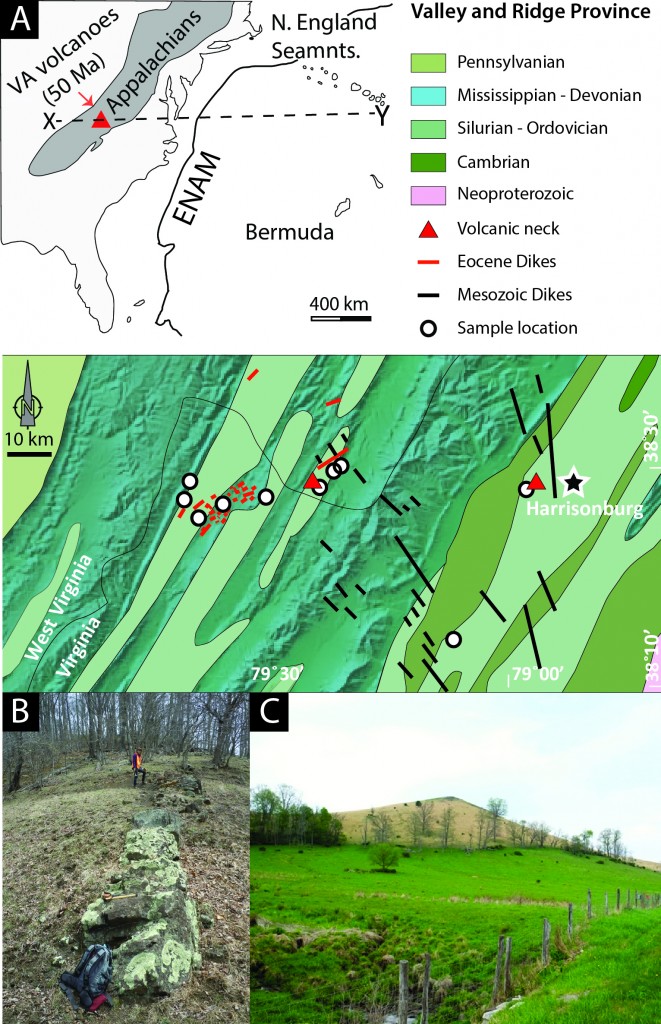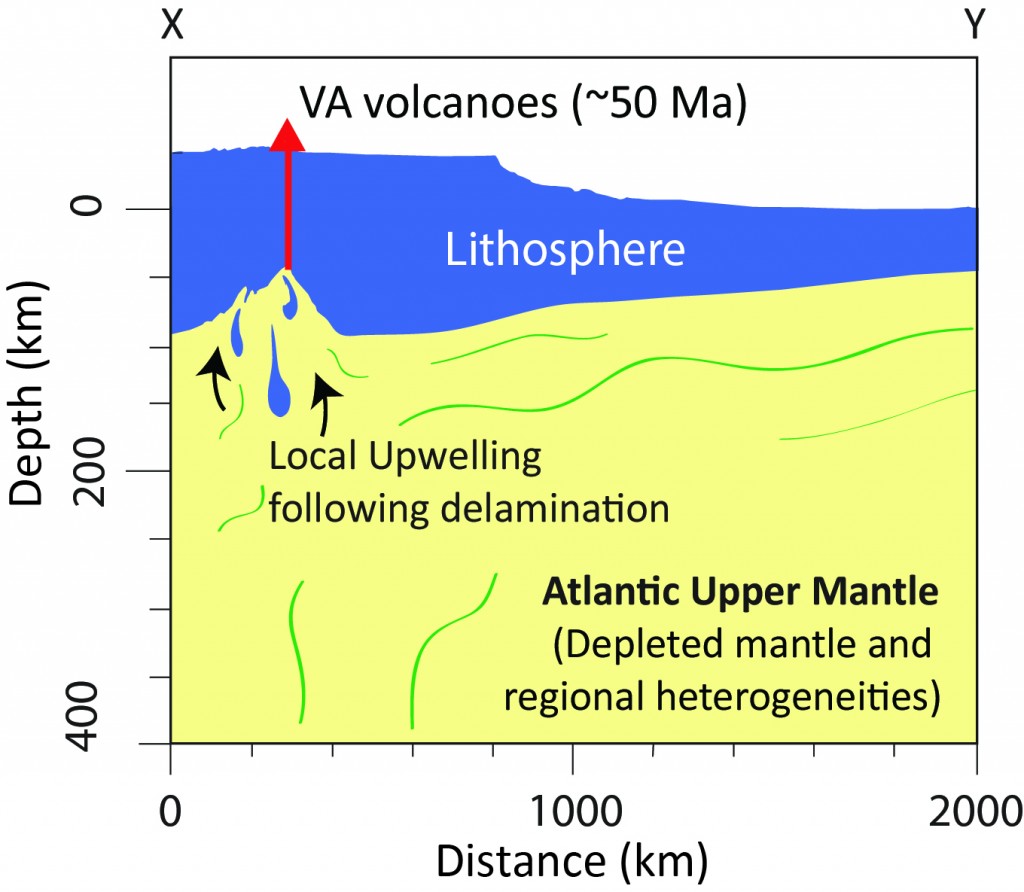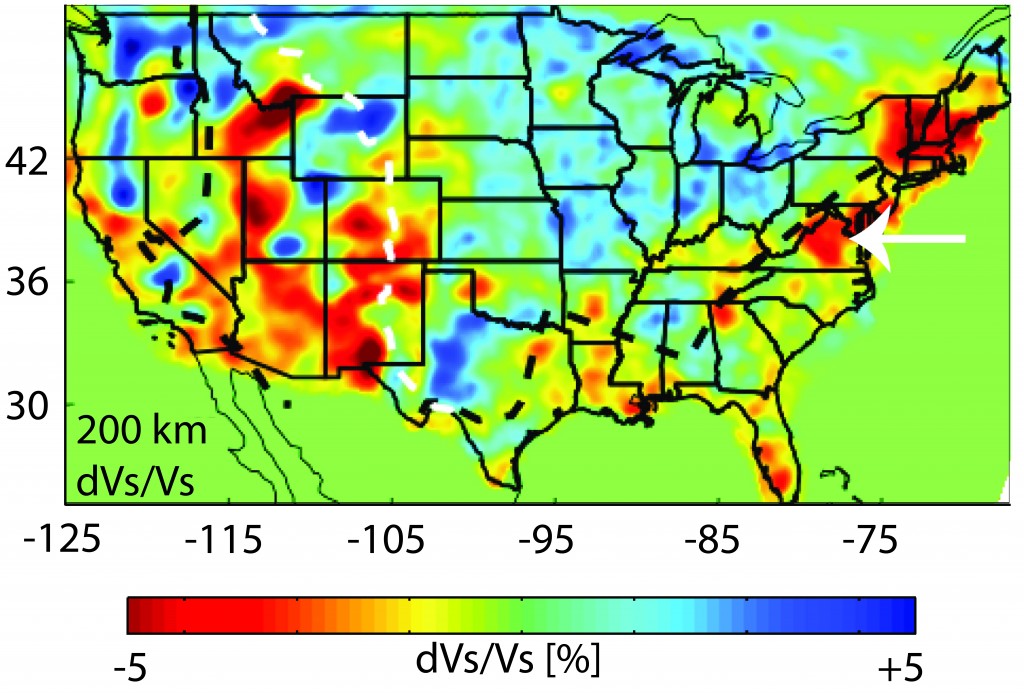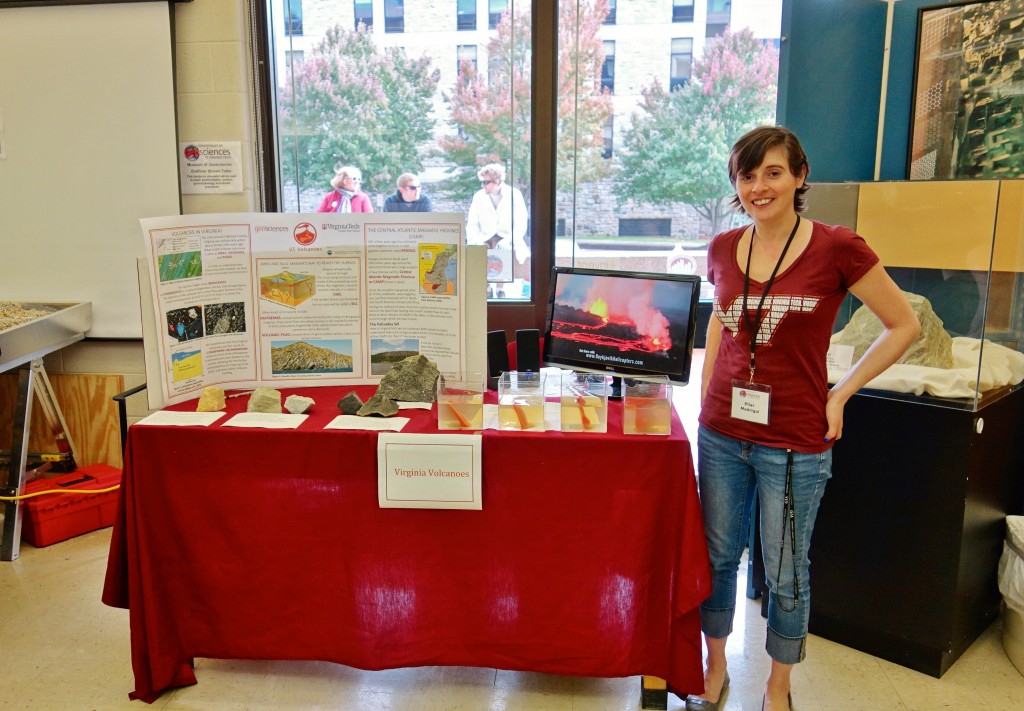Sarah E. Mazza1, Esteban Gazel1, Elizabeth A. Johnson2, Brandon Schmandt3
1 Department of Geosciences, Virginia Tech, Blacksburg, VA, 2Department of Geology and Environmental Sciences, James Madison University, Harrisonburg, VA, 3Department of Earth and Planetary Sciences, University of New Mexico, Albuquerque, NM

Figure 1. A) Simplified geologic map showing sample locations of Eocene magmas. Note the orientation of the Mesozoic Central Atlantic Magmatic Province dikes towards the northwest and Eocene dikes towards the northeast. Cross section X-Y is shown in Figure 2. ENAM – Eastern North American margin; VA – Virginia; N. – New. B) Example of basaltic dike found in Highland County, Virginia. C) Trimble Knob, an example of a diatreme in Highland County, Virginia.
The Eastern North American Margin (ENAM) developed into a passive margin following the breakup of Pangea at the Triassic-Jurassic boundary. However, the definition of “passive” no longer fits traditional tectonic thinking, as is evident from topographic rejuvenation of the central Appalachians since the late Cenozoic (e.g. Rowley et al., 2013). The recent 2011 Mineral, VA earthquake (M5.8) reminded us that the ENAM is not as stable as we would like it to be. Multiple tectonic events have shaped the ENAM and the Appalachians into a complex, lithologically diverse mountain range. The geologic record encompasses several Wilson Cycles, including the Grenville (~1.2-0.9 Ga), Taconic (~550-440 Ma), Acadian (~420-360 Ma), and Alleghanian (~320-260 Ma) orogenic events. The Appalachians and Piedmont has seen its share of magmatic activity, from Alleghanian granitic plutons to the massive Central Atlantic Magmatic Province (CAMP) occurring at 200 Ma (e.g. Blackburn et al., 2013).
The youngest known magmatic rocks in the ENAM are Mid-Eocene (Southworth et al., 1993; Tso and Surber, 2006; Mazza et al., 2014), located in the Valley and Ridge Province of Virginia and West Virginia (Fig. 1a). Over the past three years we have been conducting extensive field work, sampling over 50 different locations thus far. The Eocene volcanic rocks occur as dikes, sills, plugs, and diatremes, up to ~400 m in diameter (Fig. 1b, and c). The volcanic rocks are bimodal in composition, including mostly basalt and trachydacite. Mafic end members are generally fresher, with well-preserved mafic minerals, and some carrying lower crustal and mantle xenoliths. The felsic samples are typically rich in amphibole and biotite, both of which are useful for 40Ar/39Ar age dating.
New 40Ar/39Ar age dates have confirmed that the Virginia/West Virginia volcanics are the youngest magmatic event in the ENAM at ~48 Ma (Mazza et al., 2014). The Eocene magmatic pulse is an example of continental intraplate volcanism. Intraplate volcanism can be explained by mantle plume activity, lithospheric delamination, or simple extension. Plume-generated volcanism has elevated productivity, high mantle temperatures, and geochemical signatures indicative of deep sources (e.g. Hawaii; Herzberg et al., 2007). Lithospheric delamination can explain similar geochemical signatures as plume-derived volcanism, but with lower melting temperatures and productivity (e.g. New Zealand; Hoernle et al., 2006).
Continental extension can also produce intraplate magmas, thinning the lithosphere and allowing for decompression melting. In the case of extension, melting temperatures are expected to be close to ambient mantle and the geochemical signature would be less enriched compared to those magmas produced from mantle plume or delamination (e.g. the Basin and Range, western US; Gazel et al., 2012).
Our results show that the Eocene magmatic pulse is mantle derived and record an equilibration temperature of 1412 ± 25 °C at a pressure of 2.32 ± 0.31 GPa. Thus, melting conditions of the Eocene magmatic pulse indicates that conditions were too cold to be mantle plume derived (>1500 °C; Herzberg et al., 2007) and too hot to be related to the mantle at mid-ocean ridge systems (~1350 °C; McKenzie et al., 2005).
In order to determine a mechanism for melting, we turned to the available geophysical data. Prior to the arrival of the USArray to the east coast, Wagner et al. (2012) proposed the presence of a fossilized slab beneath North Carolina. From their Appalachian Seismic Transect, they found evidence for a westward dipping fossilized slab, which they interpret as an eclogized remnant of a west-vergent subduction zone associated with the accretion of Carolinia. However, contrasting seismic data from the TEENA Array (Test Experiment for Eastern North America; Benoit and Long, 2009) suggests a single Moho below the Shenandoah Valley of Virginia (at a depth of ~40 km). Thus, between Virginia and North Carolina, the remnant eclogized slab is lost.
Based on the geochemistry, average temperatures and pressures of melting (Mazza et al., 2014), the presence of a thickened, eclogized root in North Carolina (Wagner et al., 2012), and the lack of a thick crust in the Shenandoah Valley of Virginia (Benoit and Long, 2009) leads us to suggest that the ENAM Eocene magmatism was the result of localized upwelling in response to delamination (Fig. 2; Mazza et al., 2014).

Figure 2. Schematic model of melting mechanism by lithospheric delamination and possible mantle sources of Virginia (VA) volcanoes. Line of cross-section X-Y is shown in Figure 1A.
A recent seismic study using seismic waveforms initiated from the 2011 Mineral, VA earthquake and the USArray in the Midwestern US suggested that a hidden hotspot trail may exist beneath the ENAM (Chu et al., 2013). They modeled the possibility of a thermal anomaly’s retention over the course of tens of millions of years and predicted that it is possible for a thermal anomaly from ~50-75 Ma to still exist today. However, Chu and coauthors suggest that this thermal anomaly was the result of a plume track that passed under Virginia 60 Ma, which is ~12 m.y. too early based on the new age evidence. Our ages are younger and our calculated mantle potential temperatures are lower than expected for a plume environment. Because of these discrepancies, the data Chu et al. (2013) presented could also be interpreted as a delaminated lithosphere. Recent tomography of the ENAM using the newly arrived USArray (up to May 2014) from Schmandt and Lin (2014) shows a low-velocity anomaly at ~60-300 km depths beneath the central Appalachians (Fig. 3). Schmandt and Lin (2014) agree with our interpretation of delamination, suggesting that the Eocene delamination could have left the “thermal scar”.
If the Eocene intraplate magmatism was produced by delamination and localized mantle upwelling, then one would expect to see localized change with the topography in response to the influx of a hotter mantle. There is well documented Neogene landscape rejuvenation along the ENAM passive margin (Rowley et al., 2013 and references within), from elevated erosion, increased sedimentation rates, and alteration of drainage patterns. Due to the thermal potential of mantle derived Eocene magmas in the Virginias, there could have been a larger pulse of dynamic topographic change in the central Appalachians. Unfortunately, no indication of Eocene landscape rejuvenation has yet been identified.
With further collaboration between geochemists, geophysicists, and geomorphologists, we plan to continue to evolve our understanding of the post-rifted ENAM. Not only do we aim to better understand the evolution of the ENAM, but we hope that our future work will expand our knowledge of the mantle beneath cratons and passive margins worldwide. This project has the potential to be an excellent teaching aid, showing the complexity of the physical world we live in and thus sparking interests in the next generation of geoscientists.

Figure 3. S wave tomography at 200 km depth from Schmandt and Lin (2014). White arrow points to the location of the Virginia Eocene magmatism.
Education & Outreach

Virginia Science Festival Exhibit “Volcanoes form the inside out”. PhD Student Pilar Madrigal in the inner exhibit about melt generation and formation with examples form the VA Eocene Volcanoes and dikes in the Santa Elena Ophiolite in Costa Rica.
We have been striving to use the story of the “youngest volcanoes in the ENAM” as a teaching example. Just recently, we participated in the Virginia Science Festival with the goal of furthering the general public’s understanding of geologic processes right in their own backyard. From volcanic diking experiments to hands on exhibits, we have been encouraging the public’s interest in the geologic processes that helped shape the state they live in. At the college level, this project has funded several undergraduate research projects at James Madison University. Several of these undergraduates have been able to present their research at national and regional conferences. Reaching a broader, non-scientific audience can be challenging. We have been able to overcome the hurdle by communicating with the press, through organizations such as NPR, Scientific American, LiveScience, and the Washington Post.
